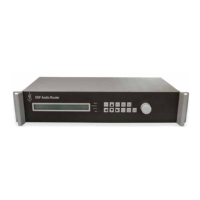VAR8 and Variants Operation, Commissioning, Fault Finding, and Maintenance Guide -
Is
Page 82 of 166
sue: 02 complete, approved
16 DVA or Route Triggers via Contact Configuration
Any Router contact or Remote I/O Unit digital input may be configured to trigger a route connecting any
desired combination of audio inputs to any combination of outputs. Audio inputs are typically DVAs, however
other type of inputs such as microphone, background music, and test tone can also be routed.
Therefore a single contact may cause an EVACUATE message to be broadcast in one zone, and
simultaneously cause an ALERT message to be broadcast to some other zones while all remaining zones
are unaffected.
It is possible to configure how the route will be triggered:
• Not Latched mode
The activation of a contact configure for Not Latched mode initiates a route. When the contact is
released, the route is cleared.
This mode is suitable for routing any type of input.
• Latched mode
A momentary, or prolonged, activation of a contact configured for Latched mode initiates a route.
A separate contact must be specified to act as a reset contact whose activation clears the route unless
the corresponding trigger is still asserted.
This mode is suitable for routing any type of input.
The DVA assigned to a button may be configured to cease playing when the route is terminated or reset
(DVA-Part), or play until its end (DVA-Full).
It is also possible to configure whether or not the route associated with a contact should cause a busy
indication on the LEDs associated with microphone zone select buttons. If for instance this routing were used
for background music control, then the busy LEDs would not be lit. If another type of route were being made,
then the busy LEDs would normally be lit.
L
The Remote I/O Unit needs to be programmed prior to configuring its inputs and outputs, see
Section “15 Remote I/O Unit or Fire Loop Interface Configuration”.

